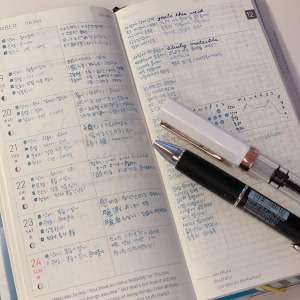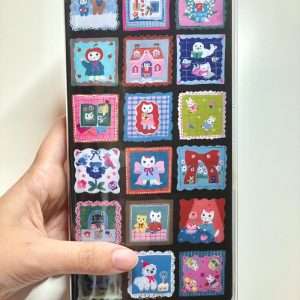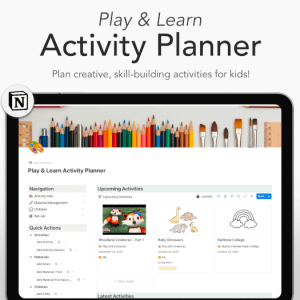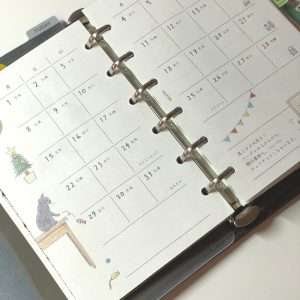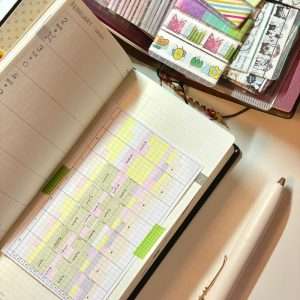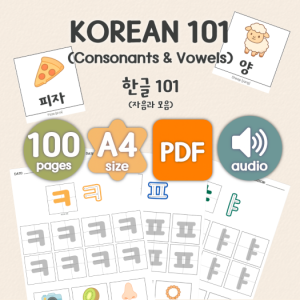System Techo vs. Bullet Journal: My 2025 Productivity Planner
System techo vs. bullet journal (aka Bujo) is a common debate among those looking for a customizable planning system. A bullet journal is a highly flexible system where users create layouts from scratch, allowing for full creative control over planning and organization. In contrast, a system techo is a modular, ring-bound planner system that allows for customization using refillable inserts, combining structure with flexibility. Last year, I used a Hobonichi Techo, but I wanted something more customizable and adoptable. As I explored different options, I considered both bullet journaling and system techo. Ultimately, I chose system techo for its flexibility without the extra effort of drawing layouts.
In this posting, I compare bullet journaling and system techo, exploring their strengths and weaknesses. I also share my personal system techo setup for 2025, explaining why I chose this planning method and how it helps me stay organized.
Table of Contents
System Techo vs. Bullet Journal: Which One Fits Your Style?
I’ve tried both approaches in the past year, and I can say each system definitely has its own strengths—and trade-offs. Many planners offer flexibility, but depending on your priorities, one will likely suit you better than the other.
What is the difference between a bullet journal and a system techo? A bullet journal is a fully customizable system where you create layouts from scratch, while a system techo uses pre-structured inserts that offer more organization with less setup.
What is a System Techo?
A system techo offers the best of both structure and customization. It allows users to choose refills that fit their needs, whether they prefer dated planner pages, blank inserts, or specialized formats. Unlike a bullet journal, pages in a system techo can be rearranged or replaced without affecting the entire setup. This saves time since users don’t need to manually create layouts. Additionally, a system techo offers various refill options, including grid, dot-grid, lined, and dated planners. It’s perfect for mixing planning styles, combining structured weekly or monthly pages with freeform notes. Another advantage is that system techo covers and rings are reusable, meaning users can keep the same planner setup and just replace the inserts each year. Personally, I liked that I could use prefilled inserts that are easy to find, which helped me avoid repetitive layout drawing. It made the setup feel less overwhelming while still customizable.
Despite these benefits, system techo planners can be overwhelming at first due to the many refill options available. Pages can also rip accidentally, especially if they’re moved frequently, which was one of the biggest reasons I avoided ring binders before. The bulkiness of the system was a close second. Compared to a simple notebook, a ring-bound system techo can take up more space. Setting up a system techo requires trial and error to determine the best format. While it provides flexibility, it still follows a structured binder format, making it less freeform than a bullet journal.
Common System Techo Questions
Q: What makes a system techo different from other planners?
A: Unlike bound planners, a system techo is a ring-bound or disc-bound planner that allows you to add, remove, and rearrange pages to fit your needs, making it more flexible than traditional planners.
Q: Can you use a system techo as a bullet journal?
A: Yes! A system techo can function like a bullet journal, but with pre-punched inserts instead of blank pages. This allows for customization while reducing the time spent setting up layouts.
Q: What are the best inserts for a system techo?
A: Popular inserts for system techo planners include monthly calendars, daily/weekly layouts, habit trackers, budget planners, and note pages. The best inserts depend on your planning style and needs.
What is a Bullet Journal?
A bullet journal offers ultimate flexibility, allowing users to design each layout exactly how they like. It provides creative freedom, making it easy to customize with art, stickers, colors, and unique formats. Since it doesn’t require pre-printed inserts, any blank notebook can be used, making it an accessible option. Bullet journaling is also great for reflection and free-form planning, ideal for journaling, tracking habits, and brainstorming. Additionally, it’s budget-friendly since there’s no need for specialized planner pages. The official Bullet Journal website, bulletjournal.com, offers detailed resources, including a structured course for those interested in learning how to set up and optimize their system. I gave bullet journaling a try once, and honestly, I had so much fun coming up with different layout ideas. Designing weekly spreads and trackers from scratch felt creative and refreshing—like a mix of planning and art.
However, bullet journaling can be time-consuming as manually drawing layouts takes effort, which was a concern for me when considering different planner options. There’s also a risk of inconsistency—it’s easy to skip weeks or forget to set up pages in advance. Without proper organization, pages can feel scattered and lack structure. Revisions can be messy since it’s difficult to move things around or erase mistakes cleanly. For those who need a quick and structured planning system, bullet journaling may not be the best option as it requires setup before use.
Common Bullet Journal Questions
Q: What are the best alternatives to a bullet journal?
A: Some great alternatives to a bullet journal include Hobonichi Techo, Traveler’s Notebook, Ring-bound planners (like Filofax or System Techo), and digital planning apps like Notion or GoodNotes. These options provide structure while still allowing customization.
- If you prefer Traveler’s Notebooks, see my guide on Customizing Traveler’s Notebook Elastic Bands for a unique DIY touch.
- If you’re considering Hobonichi Weeks Mega, check out my Hobonichi Weeks Layout Ideas for creative setups and my Hobonichi Weeks Mega Review for a detailed look at its features, pros, and cons.
- Looking for a paper-based alternative? My Analog Journaling 101 guide covers types, benefits, and tips to help you get started with handwritten journaling.
Q: Is bullet journaling a waste of time?
A: Bullet journaling can be time-consuming, but for many, it’s a valuable tool for productivity, organization, and creativity. If setting up pages feels overwhelming, using a structured planner like a Hobonichi Techo or System Techo may be a better fit.
Q: What is the difference between a bullet journal and a regular journal?
A: A bullet journal (BuJo) is a customizable planning system designed for task management, goal setting, and organization, while a regular journal is typically used for freeform writing, reflection, or personal storytelling.
Why I Chose System Techo Over Bullet Journaling
I wanted a customizable system without too much hassle of drawing layouts. To me, a system techo is somewhat a hybrid of a bullet journal and a predefined planner. For weekly planning, I prefer to use refills so I don’t have to spend too much time drawing monthly and weekly layouts. However, for other aspects like home maintenance planning, I prefer blank pages where I can freely draw and write down things as needed. The ability to swap out pages is a game-changer since I can refine my setup anytime, and being able to move the pages around as needed makes the system even more adaptable. This balance allows me to optimize my planner for both structure and creativity, making it an efficient yet flexible tool for organizing different aspects of my life.
My 2025 System Techo Setup
In this section, I detail how I set up my 2025 system techo and the thought process behind each organizational choice. My goal was to balance efficiency and creativity, so I selected refills that simplify weekly scheduling while reserving blank pages for personalized home maintenance notes and brainstorming sessions.
I’ll walk you through the decisions that helped me tailor my planner to my needs: structuring daily tasks, tracking health habits, managing both family and personal finances, and keeping my creative projects on track. This comprehensive overview showcases the practical adjustments and creative tweaks that keep my planning system flexible and effective throughout the year.
Schedule & General Planner
I use the Midori B7 2025 planner refill, which helps me manage my schedule efficiently. The weekly layout consists of two main pages:
- Left page: Divided into two columns—one for events and important tasks, and another for workout plans.
- Right page:
- Weekly goals: Set a maximum of three to maintain focus.
- Meal planning: Plan meals for the week to stay organized and reduce last-minute decisions.
- Habit tracking: Track habits to monitor progress and stay consistent.
Last year, I loved the layout of the Hobonichi Weeks, so I spent time searching for a refill that closely resembled it. I’m glad I found the Midori B7 2025 planner refill, which provides a similar structure while allowing for more customization within my system techo.
Home
My system techo also serves as a home maintenance and decluttering log, helping me keep track of various aspects of household organization. In addition to these, I also use this section for family plans, such as school plans for my little one, important dates, and other family-related planning needs. The following list includes some of the things I have in this section.
- Appliance and kitchenware inventory: I track appliances, pots, and other household items that may need replacing, including brand names and purchase dates if available.
- Plant care log: I maintain a list of major plant tasks and a wish list for future plant additions.
- Cleaning checklist: This section includes detailed cleaning plans and layouts for each room to help organize efficiently and determine the best furniture arrangements.
This setup allows me to keep a structured overview of home-related tasks, ensuring that nothing gets overlooked and making it easier to maintain an organized space.
Health
This section is where I keep track of various aspects of my health and wellness.
- Workout tracking: I log my workouts, including monthly weight and measurement comparisons, to track progress over time.
- Skincare routine: I document my skincare routine, keeping reviews of products I’ve finished and listing new ones I’d like to try. If a product truly stands out, I give it a five-star review, making it easier to remember my top favorites.
- Vaccine records: I track flu shots and other immunizations to ensure I stay up to date.
Having all this information in one place helps me stay consistent and monitor any changes, making it easier to maintain my overall well-being.
Spending
This section is not a full expense log. I use a Notion template for that purpose and have been relying on it for a couple of years. Instead, it helps me stay mindful of my personal spending habits and track non-essential purchases.
- Personal allowance tracking: I record purchases with details such as price, store, and the reason for buying, allowing me to reflect on my spending habits.
- Purchase reviews: After using an item for some time, I leave a review, marking it with a heart symbol if I loved it or an X if it was a waste of money.
- Wish list: I categorize wish list items by room or purpose and revisit them occasionally to reassess my needs. If I no longer want an item, I cross it out. When I successfully avoid an impulsive purchase, I put a small heart next to it.
By keeping this section organized, I can evaluate my spending patterns more effectively. This allows me to make more intentional purchasing decisions.
Notes & Planners
This section is where I keep track of my journaling-related notes and ideas, helping me refine and improve my planning system.
- Pen swatches: I test different pens to see how they perform on my planner pages, checking for bleed-through and drying times.
- Planner setup ideas: I jot down changes I want to make in my system techo, from layout adjustments to new inserts I’d like to try.
- Indexing system: I created my own index for my planner, documenting how I structured it so I can refer back if I need to expand or adjust it in the future.
Having this section allows me to experiment with different tools and techniques. I can also track what works best for my planning style.
Craft
This section is where I gather and refine ideas for my craft projects before committing to them.
- Project brainstorming: I write down ideas for things I might want to turn into a project. This includes general craft ideas, potential materials, and concepts I want to explore. Once I decide to work on a project, I move the detailed plans and experiment notes to my passport Traveler’s Notebook. After completing the project, I document the process or write a how-to in my regular Traveler’s Notebook.
- Craft tools inventory: I’m planning to add this section to track the tools and supplies I own. This will help me ensure I don’t purchase duplicates and can easily find what I need. I also want to include notes on tool maintenance and organization ideas to keep everything in order.
- Material wishlist: I’m planning to add this section to track specific materials I’d like to try in future projects, making it easier to stay organized when shopping for supplies.
This section helps me stay inspired and organized, giving me a space to develop ideas before committing to a full project. It ensures that when I do start a craft, I have a structured approach and all the necessary details in place.
KIUKIU
This section is where I keep track of everything related to my blog. It helps me stay organized and continuously improve my content.
- Blog post ideas: A running list of topics I want to write about, including drafts and content ideas.
- SEO research: Notes on keywords, search trends, and optimization techniques to improve post visibility.
- Site updates: Tasks such as improving LCP, refining site structure, and optimizing older posts to enhance performance.
This section has been helping me a lot as I renovate my blog. I had a ton of tasks, both big and small, and it was really hard to keep track of everything. By organizing my plans here, I can manage my workload more effectively. I also drew a layout of my blog so I can refer to it when styling the pages, making the design process smoother.
Final Thoughts

Both bullet journals and system techo planners have their strengths, but for me, the system techo has been a game-changer. It gives me the structure I need while still allowing for customization, without the overwhelming effort of setting up layouts from scratch. Since switching, I’ve not only become more organized and productive, but I also genuinely enjoy using my planner every day. Having a planning system that adapts to my needs makes all the difference, and I’m excited to see how it continues to evolve!
📝 Must-Try Journaling Ideas & Inspiration
- Stamping Essentials: My Must-Have Tools for Better Results
- System Techo vs. Bullet Journal: My 2025 Productivity Planner
- My 2025 Journal lineup: System Techo & Midori Daily Journal
- Analog vs. Digital Journaling: Which One Suits Your Needs?
- Analog Journaling 101: Types, Benefits & Best Tips
📖 Explore More Journaling Tips & Techniques
Looking for new ways to enhance your journaling practice? Discover my journaling tips, creative prompts, and organization ideas to make the most of every page!
🖊️ Popular Stationery Reviews
- Japanese Planner Accessories Haul: Stationery Finds from Tokyo
- Best Hole Punch for Ring Binders: What Worked & What Didn’t
- Uni-ball One P Review: Ink Test + Alternative Refill Options & Fica Colors
- Sew a Notebook Cover: DIY Project for Midori MD Diary
- Traveler’s Notebook Care: Tips and Leather Conditioning Guide
- Craft Organization Ideas: Simple Storage Solutions for Supplies
- Hobonichi Weeks Mega Review: Is It Worth The Hype?
🖊️ Explore More Stationery Reviews
Looking for the best stationery to enhance your journaling experience? Check out all my Stationery Reviews for detailed insights, product recommendations, and tips to help you choose the perfect tools for your creative projects!






